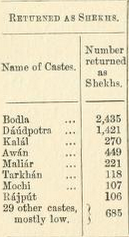The Sarai and Miana
This article is an extract from PANJAB CASTES SIR DENZIL CHARLES JELF IBBETSON, K.C. S.I. Being a reprint of the chapter on Lahore: Printed by the Superintendent, Government Printing, Punjab, 1916. Indpaedia is an archive. It neither agrees nor disagrees |
Sarai
The Sarai family are the descendants of the Kalhora Kings of Sindh who have settled at Hajipur in Derah Ghazi Khan. Some account of their history will be found in Mr. Fryer's repon: on that district, and in Mr. O'Brien's Glossary. They were included with Shekh in the divisional office, and I have no separate figures for them as yet. Tod makes the Sarai descendants, or perhaps only namesakes, of Sehl, a Kaurava Rajput and in ancient times prince of Sindh and founder of Aror on the Indus. He says : Sehl or Sehr became a titular appellation of the country, its princes, and its inhabitants the Sehrai. (See further Sarai under Jats of the western sub-montane, section 433).
Miana
Mian is used in the west of the Panjab to denote any holy man and his descendants will often style themselves Miana. Thus the head of the Sarai family just described is known as the Mian Sahib Sarai. But in Hazara at least and probably in other parts of the frontier, any newconvei-t to Mahomedanism is often called a Miana, and most of them are cultivators. I have with some hesitation classed them as Shekh rather than with Ulama. There are 3,282 in the Rawalpindi and 188 in the Derajat division.
Besides the classes discussed above, the castes shown in the margin appear from a rough examination of the Shekh sub-divisions to have returned themselves as Shekhs in the numbers shown against each. They are described in their proper places. Of the Bodlas returned as Shekhs 144 are in Hissar, 749 in Sirsa, 339 in Firozpur, 349 in Montgomery, and 254 in Bahawalpur. Of the Daudpotras 1,287 are in Multan. Besides these, men returning themselves under the following names have been classed as Shekh : Shekhra, a contemptuous diminutive of Shekh ; Pirzadah, or descendants of ap«^y or Musalman spiritual guide ; Shekhzadah, or son of a Shekh. There appear to have been only 383 of the first, 19 of the second, and 17 of the third. In the Lahore division the Bharais (caste No. 48) have been most erroneously classed as Shekh, to the number of 1,444 in Lahore, 2,256 in Gujranwala, and 1,646 in Firozpur.
